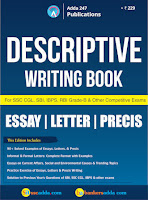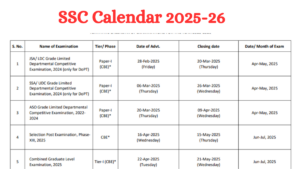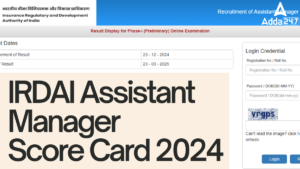Dear Aspirants,
As NABARD exam is approaching, you must practice and pay attention to all the subject and section to maximise your score in the final exam. Computer Knowledge section can help you to improve your overall score if in case other sections are tougher than the expectation. Solve or Answer these 15 Computer Knowledge Questions to test your preparation for NABARD Grade-A and other upcoming Bank Exams of 2018.
Q1. ODBC stands for _____________.
(a) Object Database Connectivity
(b) Oral Database Connectivity
(c) Oracle Database Connectivity
(d) Open Database Connectivity
(e) Oriental Data Balance Connection
Show Answer
S1. Ans.(d)
Sol. Open Database Connectivity (ODBC) is an open standard application programming interface (API) for accessing a database.
Sol. Open Database Connectivity (ODBC) is an open standard application programming interface (API) for accessing a database.
Q2. Which among the following are valid filters available in MS Access?
(a) Filter by form
(b) Filter by selection
(c) Common Filter
(d) Advanced filter
(e) All of the above
(a) Filter by form
(b) Filter by selection
(c) Common Filter
(d) Advanced filter
(e) All of the above
Show Answer
S2. Ans.(e)
Sol. Common filters: To filter for specific values or a range of values.
Sol. Common filters: To filter for specific values or a range of values.
Filter by Selection: To filter all the rows in a table that contains a value that matches a selected value in a row by filtering the datasheet view.
Filter by form: To filter on several fields in a form or datasheet, or if you are trying to find a specific record.
Advanced filter: To filter type where you define custom filter criteria.
Q3. Who invented the machine to add numbers quickly and accurately?
(a) Joseph Marie Jacquard
(b) Gottfried Wilhelm von Leibniz
(c) Blaise Pascal
(d) Herman Hollerith
(e) Both (a) and (b)
(a) Joseph Marie Jacquard
(b) Gottfried Wilhelm von Leibniz
(c) Blaise Pascal
(d) Herman Hollerith
(e) Both (a) and (b)
Show Answer
S3. Ans.(c)
Sol. Blaise Pascal developed a machine that was used to perform additions quickly and accurately. This machine was called the adding machine or Pascaline.
Sol. Blaise Pascal developed a machine that was used to perform additions quickly and accurately. This machine was called the adding machine or Pascaline.
Q4. Which output device transfers processed information into a printed page?
(a) Scanner
(b) Printer
(c) Monitor
(d) CD-ROM
(e) Digital Camera
(a) Scanner
(b) Printer
(c) Monitor
(d) CD-ROM
(e) Digital Camera
Show Answer
S4. Ans.(b)
Sol. Printers transfers processed information into printed page. Different types of printer are Ink Jet, Laser, drum etc.
Sol. Printers transfers processed information into printed page. Different types of printer are Ink Jet, Laser, drum etc.
Q5. Which of the following units performs the arithmetic tasks (such as addition, subtraction, multiplication and division) and logical operations?
(a) Input unit
(b) Control unit
(c) Arithmetic Logic Unit (ALU)
(d) Storage unit
(e) Memory Unit
(a) Input unit
(b) Control unit
(c) Arithmetic Logic Unit (ALU)
(d) Storage unit
(e) Memory Unit
Show Answer
S5. Ans.(c)
Sol. Arithmetic Logic Unit (ALU) performs arithmetic and logical operations. On the other hand, control unit extracts instructions from the computer memory, decodes and executes instructions, and takes help of the ALU if required. Storage unit or memory unit is used to store the data, while the input is used to enter data into the computer.
Sol. Arithmetic Logic Unit (ALU) performs arithmetic and logical operations. On the other hand, control unit extracts instructions from the computer memory, decodes and executes instructions, and takes help of the ALU if required. Storage unit or memory unit is used to store the data, while the input is used to enter data into the computer.
Q6. From which version Microsoft introduced Backstage View for Access Interface?
(a) Access 2003
(b) Access 2007
(c) Access 2010
(d) Access 2000
(e) Access does not have Backstage View
(a) Access 2003
(b) Access 2007
(c) Access 2010
(d) Access 2000
(e) Access does not have Backstage View
Show Answer
S6. Ans.(b)
Sol. In Microsoft Office applications (Word, Excel, PowerPoint, Outlook, Access), versions 2007 and later there is an option for the backstage view that allows you to manipulate aspects of a file.
Sol. In Microsoft Office applications (Word, Excel, PowerPoint, Outlook, Access), versions 2007 and later there is an option for the backstage view that allows you to manipulate aspects of a file.
Q7. What is the maximum font size you can apply for any character?
(a) 163
(b) 1638
(c) 16038
(d) 160
(e) None of above
(a) 163
(b) 1638
(c) 16038
(d) 160
(e) None of above
Show Answer
S7. Ans.(b)
Sol.1638 is the max font size that can be applied for any character.
Sol.1638 is the max font size that can be applied for any character.
Q8. If you change Windows 98 to Windows XP, which action will you be performing?
(a) Revise
(b) Upgrade
(c) Update
(d) Patch
(e) None of these
(a) Revise
(b) Upgrade
(c) Update
(d) Patch
(e) None of these
Show Answer
S8. Ans. (b)
Sol. It will be called upgrade.
Sol. It will be called upgrade.
Q9. Which among the following is Microsoft’s core set of application programming interfaces (APIs) available in the Microsoft Windows operating systems?
(a) Kernel
(b) WinAPI
(c) Windows ME
(d) DOS
(e) None of these
(a) Kernel
(b) WinAPI
(c) Windows ME
(d) DOS
(e) None of these
Show Answer
S9. Ans. (b)
Sol. The Windows API, informally WinAPI, is Microsoft’s core set of application programming interfaces (APIs) available in the Microsoft Windows operating systems. The name Windows API collectively refers to several different platform mplementations that are often referred to by their own names (for example, Win32 API). The Windows API (Win32) is focused mainly on the programming language C in that its exposed functions and data structures are described in that language in recent versions of its documentation.
Sol. The Windows API, informally WinAPI, is Microsoft’s core set of application programming interfaces (APIs) available in the Microsoft Windows operating systems. The name Windows API collectively refers to several different platform mplementations that are often referred to by their own names (for example, Win32 API). The Windows API (Win32) is focused mainly on the programming language C in that its exposed functions and data structures are described in that language in recent versions of its documentation.
Q10. Which of the following is not aggregate function?
(a) MIN
(b) MAX
(c) AVG
(d) COUNT
(e) None of these
(a) MIN
(b) MAX
(c) AVG
(d) COUNT
(e) None of these
Show Answer
S10. Ans. (e)
Sol. All of these are aggregate functions.
Sol. All of these are aggregate functions.
Q11. For each attribute of a relation, there is a set of permitted values, called the __________ of that attribute.
(a) Domain
(b) Relation
(c) Set
(d) Schema
(e) None of these
(a) Domain
(b) Relation
(c) Set
(d) Schema
(e) None of these
Show Answer
S11. Ans. (a)
Sol. Set of permitted values is called the domain of that attribute.
(Relation is a table. Attributes describe the instances in the row of a database.)
Sol. Set of permitted values is called the domain of that attribute.
(Relation is a table. Attributes describe the instances in the row of a database.)
Q12. The __________ operation performs a set union of two ‘similarly structured’ tables.
(a) Union
(b) Join
(c) Product
(d) Intersect
(e) None of these
(a) Union
(b) Join
(c) Product
(d) Intersect
(e) None of these
Show Answer
S12. Ans. (a)
Sol. Union operation performs a set union of two ‘similarly structured’ tables.
Sol. Union operation performs a set union of two ‘similarly structured’ tables.
Q13. __________ is usually recorded and played, displayed, or accessed by information content processing devices, which as computerized and electronic devices, but can also be part of live performance.
(a) Virus
(b) BIOS software
(c) Multimedia
(d) C++
(e) None of these
(a) Virus
(b) BIOS software
(c) Multimedia
(d) C++
(e) None of these
Show Answer
S13. Ans. (c)
Sol. Multimedia is the field concerned with the computer-controlled integration of text, graphics, drawings, still and moving images (Video), animation, audio, and any other media where every type of information can be represented, stored, transmitted and processed digitally.
Sol. Multimedia is the field concerned with the computer-controlled integration of text, graphics, drawings, still and moving images (Video), animation, audio, and any other media where every type of information can be represented, stored, transmitted and processed digitally.
Q14. The software that is used to create text based documents is referred as :
(a) DBMS
(b) Suits
(c) Spreadsheets
(d) Presentation software
(e) Word processor
(a) DBMS
(b) Suits
(c) Spreadsheets
(d) Presentation software
(e) Word processor
Show Answer
S14. Ans. (e)
Sol. Word processors are used to create text based documents.
Sol. Word processors are used to create text based documents.
Q15. ______ is a superset of keywords, symbols and a system of rules for constructing statements by which human can communicate the instructions to be executed by a computer.
(a) A computer program
(b) A programming language
(c) An assemble
(d) Computer I/O Device
(e) None of these
(a) A computer program
(b) A programming language
(c) An assemble
(d) Computer I/O Device
(e) None of these
Show Answer
S15. Ans. (b)
Sol. A programming language is a formal computer language or constructed language designed to communicate instructions to a machine, particularly a computer. Programming languages can be used to create programs to control the behaviour of a machine or to express algorithms.
Sol. A programming language is a formal computer language or constructed language designed to communicate instructions to a machine, particularly a computer. Programming languages can be used to create programs to control the behaviour of a machine or to express algorithms.






 The Hindu Review October 2022: Download ...
The Hindu Review October 2022: Download ...
 SSC Calendar 2025-26 Out, Check SSC CGL,...
SSC Calendar 2025-26 Out, Check SSC CGL,...
 IRDAI Assistant Manager Score Card 2024 ...
IRDAI Assistant Manager Score Card 2024 ...




